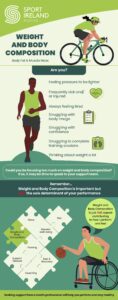A series of body composition infographics
An athlete’s body shape, weight and composition will change throughout their lifespan due to growth, development, and training adaptations. Despite this, a fixed view of an athlete’s optimal state is often adopted (1). Due to the differing physical requirements of various sports, body weight, and composition are important to performance and as such, are commonly discussed by athletes, coaches, and support staff. Many conversations and comments occur about the body weight and composition of athletes, intentionally and unintentionally (2, 3). These comments may adversely impact the performance and physical and mental health of athletes (1, 2, 3). It is therefore important to emphasise to all involved in the high-performance sporting environment the need for individual plans and avoidance of comparisons between athletes.
Sport Ireland Institute acknowledges the complexities surrounding body weight and composition in athletes and recognises the duty of care to safeguard physical and mental health. With this in mind, in 2023 a body composition working group was formed. This consisted of Sport Ireland Institute discipline representatives e.g., physiology, nutrition, medicine, psychology, strength and conditioning, along with representatives from Sport and Exercise Nutrition Group BDA and University of Sao Palo. The aim was to raise awareness of the complexities of body composition as a performance variable and to develop educational resources to support athletes, coaches, practitioners and the wider sporting community on the complexity of this area.
We have since developed and piloted the following infographics:
- Body composition and raising awareness;
- Communication relating to body composition;
- Refocusing away from body composition;
- & 5. Outline of implications when focusing too much on body composition (female (4) and male (5)).
A pilot study was undertaken in February 2023 to establish the clarity of the infographics for online administration and for dissemination among practitioners working within a high-performance environment. Feedback was incorporated into the current infographics to enhance clarity before use.
The overall development of body weight and composition infographics by Sport Ireland Institute has contributed to accelerating athlete development, recovery, and performance in the high-performance setting.
Furthermore, future research should explore athletes’ perception and experience of body composition assessment. This research will give greater insight from an athlete’s perspective and is necessary to gain a greater understanding among coaches and support staff.
Infographics
Click here for PDF of infographic 1: Body composition and raising awareness

Click here for PDF of infographic 2: Communication relating to body composition

Click here for PDF of infographic 3: Refocusing away from body composition

Click here for PDF of infographic 4: Outline of implications when focusing too much on body composition (females)

Click here for PDF of infographic 5: Outline of implications when focusing too much on body composition (males)

Authors:
Logue, Danielle; Sport Ireland Institute,
Cullen, SarahJane; Dublin City University, School of Health and Human Performance; Sport Ireland Institute
Dolan, Eimear; University of São Paulo, Applied Physiology & Nutrition Research Group
Browne, Jo-Anne; Sport Ireland Institute
Sutton, Louise ; Leeds Beckett University – Headingley Campus, Institute for Sport, Physical Activity and Leisure, Centre for Sport Performance, School of Sport
McCarthy, Martina; Sport Ireland Institute
Hayes, Valerie; Sport Ireland Institute
Macnaughton, Lindsay; Durham University, Department of sports and exercise science
Pereira Vargas, Maria ; Durham University
Madigan, Sharon; Sport Ireland Institute
References
- Langbein RK, Martin D, Allen-Collinson J, Crust L, Jackman PC. “I’d got self-destruction down to a fine art”: a qualitative exploration of relative energy deficiency in sport (RED-S) in endurance athletes. J Sports Sci. 2021 Jul;39(14):1555-1564. doi: 10.1080/02640414.2021.1883312. Epub 2021 Feb 11. PMID: 33573478.
- Stoyel H, Delderfield R, Shanmuganathan-Felton V, Stoyel A, Serpell L. A Qualitative Exploration of Sport and Social Pressures on Elite Athletes in Relation to Disordered Eating. Front Psychol. 2021 Apr 23;12:633490. doi: 10.3389/fpsyg.2021.633490. PMID: 33967900; PMCID: PMC8103200.
- Logue DM, Mahony L, Corish CA, Tobin D, Doherty R, O’Higgins G, Madigan SM. Athletes’ and Coaches’ Perceptions of Nutritional Advice: Eating More Food for Health and Performance. Nutrients. 2021 Jun 3;13(6):1925. doi: 10.3390/nu13061925. PMID: 34205107; PMCID: PMC8227796.